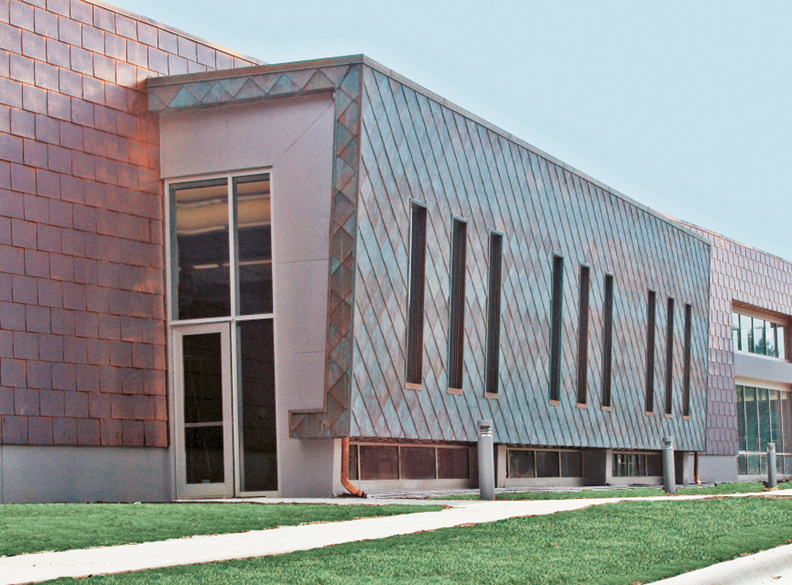As OPN Architects, Cedar Rapids, Iowa, set out to design a new library for the residents of Moline, Ill., they acknowledged the library as an institution has evolved from a traditional space reserved for individual reading and research into an energizing, interactive, technology-based community resource.
OPN envisioned a design that reflected the library’s modern role in society, while remaining true to its traditional character. The firm concluded that a building of contemporary design featuring time-honored building materials would best achieve their design aesthetic. Hallmarks of conservative design, brick, stone, glass, and copper were selected.
OPN saw an opportunity to break copper away from its conventional use and employ it in an innovative, fresh manner--as a building material. They envisioned using decorative copper panels to create the look of a heavy plate copper shingle. The design objective was impressive, but OPN Architects knew using copper in this unique fashion presented two significant challenges: cost and durability. They turned to ALPOLIC Materials for a solution.
OPN Architects recognized that ALPOLIC’s copper composite material offered five significant benefits:
- The use of genuine copper
- Significant cost savings over the use of copper sheets
- The appearance of heavy-gauge copper in a light-weight material
- Durability
- Reduced production and fabrication time
Another challenge of working with copper is the “oil can effect”--the slight undulations that can occur if the copper is not of sufficient gauge. Due to the rigidity of the ALPOLIC panel, the “oil can effect” problem was eliminated.
Project Summary: Moline Public Library
BUILDING TEAM
Owner/developer: City of Moline, Ill.
Architect: OPN Architects
General Contractor: Russell Construction
Fabricator: Metal Design Systems Inc.
Panel Manufacturer: ALPOLIC
Products: 2mm PE Copper Metal; 4mm Mica Platinum
Amount of Material: 18,600-sf
OPN Architects also enlisted the help of Metal Design Systems Inc. (MDS), a fabricator based in Cedar Rapids, Iowa. MDS developed a one-of-a-kind post patina process that provided ALPOLIC’s copper composite with a unique, rich finish. OPN Architects used ALPOLIC’s PE Copper Metal in its un-altered state in tandem with the in-house patina copper. The materials will evolve independently as well as in harmony, creating a distinctive organic finish that will change as the material matures. The copper’s “living” effect mimics the energy of the library itself.
ALPOLIC panels in the Mica Platinum finish were also used on the Moline Public Library project--both on the exterior and interior, providing additional aesthetic appeal and durability.
OPN Architects and MDS agree; ALPOLIC’s copper composite made the Moline Public Library’s innovative design objective possible. BD+C
Related Stories
Cultural Facilities | Feb 25, 2015
Edmonton considering 'freezeway' to embrace winter
If the new Edmonton Freezeway is constructed, residents will have an 11-km course that winds through the city and allows them to skate to work, school, and other city activities.
Building Team | Feb 24, 2015
Call for entries: 2015 Giants 300 survey
The annual Giants 300 Report ranks the top AEC firms in commercial construction, by revenue.
Industrial Facilities | Feb 24, 2015
Starchitecture meets agriculture: OMA unveils design for Kentucky community farming facility
The $460 million Food Port project will define a new model for the relationship between consumer and producer.
University Buildings | Feb 23, 2015
Future-proofing educational institutions: 5 trends to consider
In response to rapidly changing conditions in K-12 and higher education, institutions and school districts should consider these five trends to ensure a productive, educated future.
Office Buildings | Feb 23, 2015
The importance of quiet and the consequences of distraction
Recent work style studies show that the average knowledge worker spends 25-35% of their time doing heads-down focused work. Once thrown off track, it can take some 23 minutes for a worker to return to the original task.
Modular Building | Feb 23, 2015
Edge construction: The future of modular
Can innovative project delivery methods, namely modular construction, bring down costs and offer a solution for housing in urban markets? FXFOWLE’s David Wallance discusses the possibilities for modular.
| Feb 23, 2015
6 trends changing the way city dwellers live
Across the cultural grid, from food to retail to transportation, America's urban areas are already undergoing a major metamorphosis. Here are the six major trends shaping our cities, from Fast Company.
Green | Feb 23, 2015
State of the green union, and the next big shift in sustainability
The history of the green movement offers cues that we are on the precipice of another significant shift in the green union.
| Feb 23, 2015
Where are the iconic green buildings?
What does a green building look like? How would you know one if you saw one? Maybe a trivial question to some, but of great interest to architects, designers, and other members of the Building Team as the rapid evolution of sustainable buildings continues apace.
Sports and Recreational Facilities | Feb 21, 2015
Pumped-up recreation centers help build body, mind, and spirit
Adopting facility layouts from Asian and European models, today’s sports and recreational buildings are becoming social hubs that accommodate a variety of community needs.















